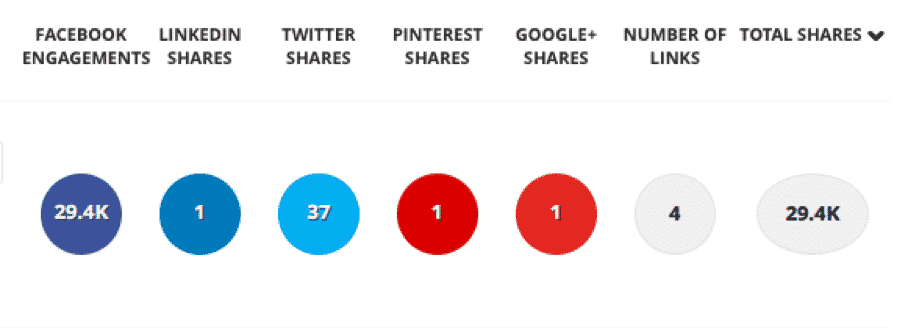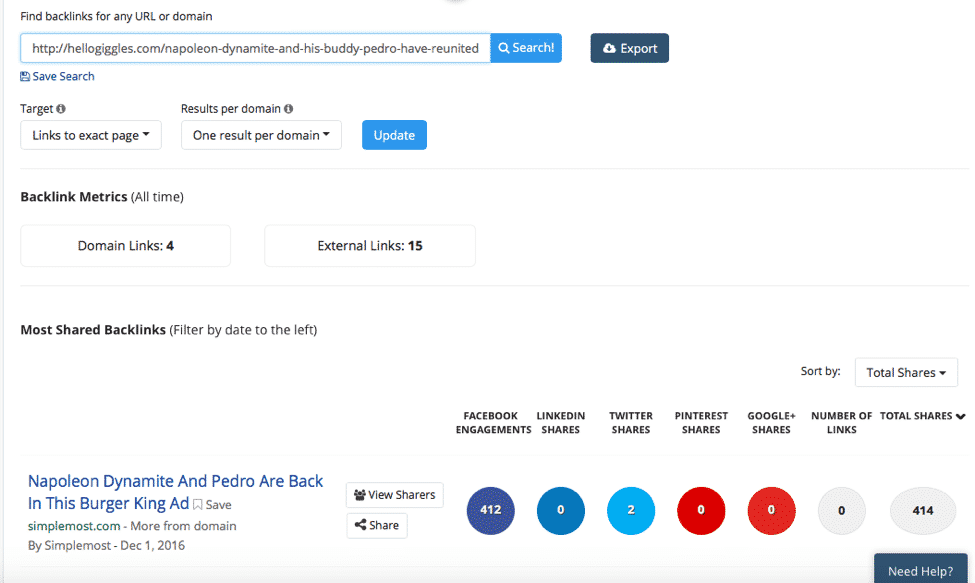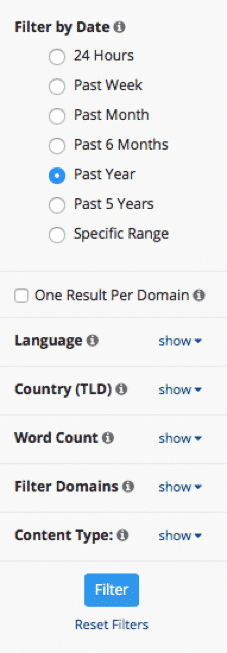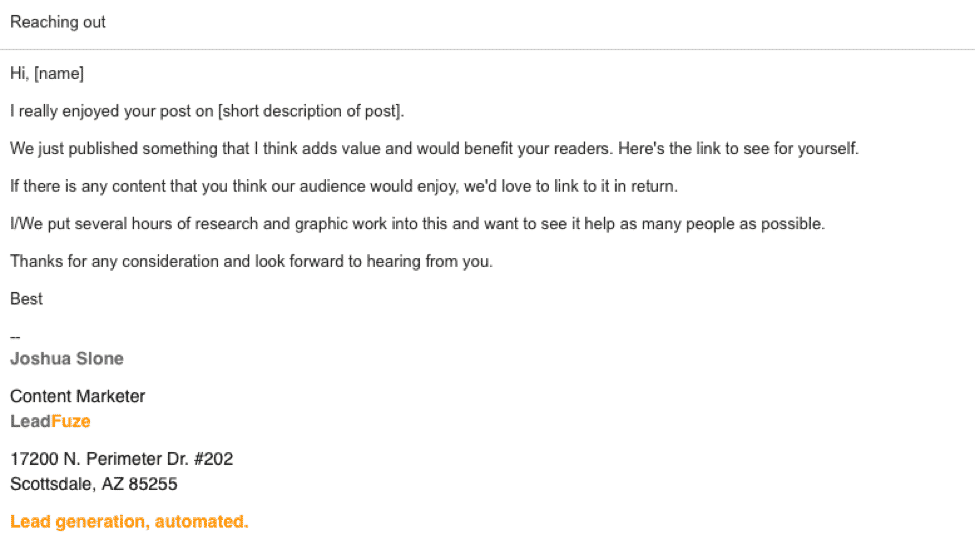Post by Justin McGill
Sometimes I watch videos about cold calling, I’ll admit it.
Most of them are real estate agents, and while it’s still difficult, there are a lot of benefits to calling people you don’t know and talking about their house. You see, most cold calling doesn’t work as well because you’re calling to talk about your stuff.
Some agents even go door-to-door and their prospects are literally exactly where they need to be already—their house.
At this point in the post, you’re thinking, “What does that have to do with white hat link building and outreach?”. My point is, link outreach is something that I believe is super low-hanging fruit for just about any website or business.
You’re essentially finding good content on a nice ranking site, complementing the owner and asking if you can help make it better, especially with your awesome content.
Sure, it doesn’t work most of the time, but you only need to sell one big house get one big link for it all to be worthwhile. Your site is in front of their traffic and maybe even their social networks of thousands.
How? By going door to metaphorical door.
Here’s a look at what we’ve learned at LeadFuze along with a quick template toward the end.
Step One: Find Good Content
Less than a decade ago, you could find a decent keyword and pop out a “Top 10” list in no time.
Get some links built to it and watch it soar.
Nowadays, things aren’t as easy. Those top 10 lists still thrive, but virality and massive linkage escapes what is now viewed as common content. Posts that were once viewed as pillar content, now gets a collective “meh” from the internet world.
Instead of an authority figure, you’re looking like someone who’s begging for attention—trying to make a quick buck.
There are a couple places to find good content, but this is the easiest step.
1. You Know Where
You know who the influencers are in your industry. You also know the content that has affected you in your journey.
Find those posts, topics and themes that really get people going. Social shares and mentions, blog comments, and links going to specific pages. Looking around those blogs you already read should give you a good idea of the content you need to improve upon.
2. BuzzSumo
Even if you know the style and type of content that your audience is already enjoying, it wouldn’t hurt to do some more research on BuzzSumo.
There are a lot of tips that you should use it, but they’re typically just to pick out popular content or to find new influencers. That’s great, but it has so much more to offer in terms link finding.
Here’s a screenshot from a goofy search I did. If you thought “Napoleon Dynamite” was a popular topic, you were right. But let’s get just a tad deeper.

 Beyond the social shares, you have links. You can actually see them, too (see next screenshot). So, not only do you come away with shareable content. You also get a list of sites to reach out to that have already shared something similar.
Beyond the social shares, you have links. You can actually see them, too (see next screenshot). So, not only do you come away with shareable content. You also get a list of sites to reach out to that have already shared something similar.
One step further, you can sort the search by date.
This can be beneficial in a couple of ways.
Short-Term: Let’s say you just wrote an awesome piece of content and you want to get links. Search for similar posts in the past month and reach out to those sites. The content is new enough and, if your resource is valuable, will help their post gain traction and be more beneficial to their audience. It’s a real win-win-win.
The folks at FitSmallBusiness did this to us, actually. We had just created an infographic that fit one of their amazing posts and they asked us for a link. We were happy to link to it, because of the initiative and the quality of the content.
Long-Term: The enterprise plan lets you go back five years, but the “Pro” and free searches go back a year. Content that old is waiting to be dethroned by something better. Write it and watch it go.
Which takes us to our next step.
Step Two: Write Better Content
Getting links “door-to-door” means that you and the content have to look they way you want to be treated. In other words, you’re authority in a niche or industry is dependent on the quality of the product and content you put out.
It’s not just about image, it’s about the reality of the value you represent. There is no cutting corners on this one. Don’t just look the part, be the best on the topic of choice.
Here are a couple of tips to help:
- More Than “One Up”: If someone has the 14 best tips for Selling TupperWare, don’t just write 15 steps. Make it the new standard. It’s not a world record, a few seconds faster here won’t impress anyone. (Example: Lilach Bullock has a phenomenal list of 450+ guest posting opportunities. It’ll be a long time before anyone does any better.)
- Make It Easier: Having a massive list or guide is awesome, but the next step is to make it function better. Several tools exist to help make clickable table-of-content style content and organizable data. (Example: Brian Dean from BackLinko created the best list of SEO tools ever created.).
- Give It a Running Start: Try, as best you can, to get some social proof before you go knocking on doors. You can boost it on FB, send an email to your list asking nicely to share, or reach out to your friends and family to share it if they like it. Just get the numbers up.
Step Three: Create a Spreadsheet
Ok, so you should really be using this from the start.
Creating the spreadsheet should be the first thing you do. You’ll be doing all of that sweet research and you’ll need a place to put it. But have you ever tried to make your first blog point “make a spreadsheet”?
I’m sure it would work for some topics, but it could have stopped this one cold.
The good news here is that it won’t take that long, but it’s absolutely crucial to outreach. Here’s a screenshot of a basic one we have begun using (more on that in a second); followed by the individual fields you may want to use.
Fields of Interest
- Name of Influencer/Site: This is for when you’re sending your emails to actually speak to the right person. If there isn’t a direct name, just use something like “Hi, [site name] team! To start off your pitch.
- Link to Similar Post: Just copy and paste the link to the post you’d like your target to put your link in. Make sure it’s a close fit and adds value to their audience they have to see it and want to go in and edit their already finished content. If your list of links isn’t long enough, do a quick Google search for related topics and add them to the list.
- Link to Social Account: Find the person in charge and get their primary social media account. This is also a great way to find more sites to reach out to, because they’re sharing similar content already.
- Email/Contact Form Link: Obviously you need to know where to send the pitch.
- Outreach Date: When was the first email sent? Also, you may want to include a space for follow-ups.
- Response: When and how did the influencer respond? May just want to put a date of response and a Y/N to help you put that outreach to bed.
- Link to Our Content: Put in the link to your content to keep things nice and tidy. This will help you if you decide to sell your site in the future. It will also tell you to stop contacting that person (for this post, anyway).
Step Four: Go Door-to-Door
At LeadFuze, we actually tried to systematize our outreach too much.
We wrote a ton of content, like 1500+ words a day, and sent it to the same few dozen groups and newsletters. Unfortunately, we found out (the hard way) that you can get shunned from lists like that.
The content was good, but the outreach wasn’t what it should be.
It takes more time, but an epic piece of content every week or two with a fresh spreadsheet of names who may want to share it and link to it is way more valuable and a better way to spend your content marketing time.
But, It Won’t Work Unless They Want It
That means you have to sell it. Here are a few tips we’ve picked up.
- Use a CRM: Sure, some of these emails should be highly personalized. But with tools like Streak so readily available it makes sense to see how things are progressing. It will also help cut down time spent.
- Butter Them Up: You took down their social account right? Well, follow them. Like their stuff. Prove yourself to be useful and engaging. You may not have much time to do this. (Don’t follow them on Twitter and send them a cold email before they’ve cleared you off their notification list.)
- Use a Template: Write a good template using some good cold email tips and then tweak it every couple hundred outreaches or so to see if you can improve the response rate and increase the links you get.
Speaking of Templates
Here’s a screenshot from our content manager’s email account for you to snag the copy from to get you started.
Ready to Start Knocking?
Anyone can start a decent looking site, start writing awesome content about the things they know and find people who are writing similar things.
And more and more are doing just that. To stand out, you have to go outside and interact with the world around you.
When you add consistent, genuine outreach you’ll step out of the pack and gain traction. Using the simple things in this post can make just about any industry site an authority within 6-months to a year.
But are you going to try it?
Author Bio:
Justin McGill is the Founder of LeadFuze, an automated outbound marketing platform for companies that want to generate more leads.







